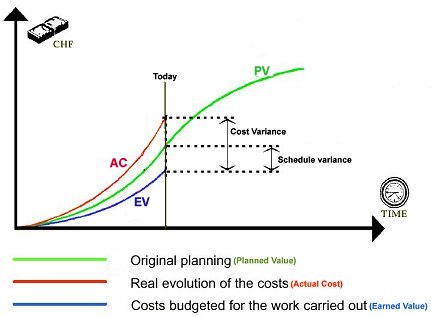|
Planned
Value (PV):
Example:
we have an 8 week activity with a 10KCHF budget linearly distributed.
After 2 weeks, we have PV=10KCHF*2/8=2.5 KCHF.
The
portion of work expected to be completed at a given date,
times the authorized budget allocted to carry out that work.
Amount of work scheduled measured as an estimation in CHF.
In former project management jargon, it is the budgeted
cost of work scheduled (BCWS).
Earned
Value (EV):
Example:
If the 8 week activity consists at manufacturing and delivering
10 magnets (linearly distributed), then when the 6 magnets
are delivered: EV=10kCHF*6/10=6 kCHF.
The
value of completed work expressed in terms of the budget assigned
to that work.
Actual
Cost (AC):
Example:
If when statusing you have paid 7 kCHF, these are your actual
costs.
The
costs actually incurred and recorded in accomplishing the
work performed.
Budget
at completion:
The total authorized budget for accomplishing the program
scope of the work. In other words, it is the sum of the planned
values at completion of the project.
|
Pre-requisites
to setting up an EVM system
A
clear scope of work is a pre-requisite for setting up
such a system. A WBS (Work Breakdown Structure) is probably
the best mean for doing so.
The
WBS is a structured list of all the activities to carry
out in order to complete a project. For each single
activity, all the resources required (material, manpower,
overheads...) must be identified and quantified. Allocated
budgets should be based on these estimates. Short term
activities are easier to estimate and schedule than
long term activities; therefore EVM standards allow
that long term activities remain agregated in planned
packages with unallocated budgets.
|
|

|
The
performance of the project, or sub-project, or of a
single activity is measured using few indices:
Schedule
variance (SV):
compares the actual physical progress (EV) to the planned
one (PV): SV=EV-PV
If SV is negative, this means that the activity is behind
schedule.
If SV is positive, the activity is ahead of schedule.
Example:
Using previous example, if 6 magnets are delivered at
the end of week 6, then EV=6 kCHF and PV=7.5kCHF, then
SV= -1.5kCHF
Cost
variance (CV):
compares the actual costs (AC) to the actual physical
progress, i.e the earned value (EV):.
CV=EV-AC
If CV is negative, this means that the budget tends
to be overrun
If CV is positive, the budget tends to be underrun.
Using previous example, let's
statusing at end of week 6:
• at that date, PV = 10 kCHF × 6/8 = 7.5 kCHF
• if 6 magnets are delivered at the end of week 6: EV
= 10 kCHF × 6/10 = 6 kCHF
• if incurred expenditures are 7 kCHF, then AC = 7 kCHF.
SV
= 6 kCHF - 7.5 kCHF = -1.5 kCHF < 0 activity is behind
schedule.
CV = 6 kCHF - 7 kCHF = -1 kCHF < 0 the budget is being
overrun!
|
|